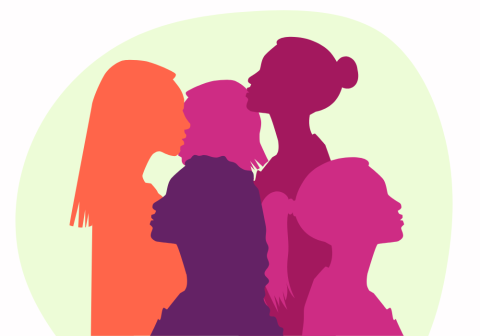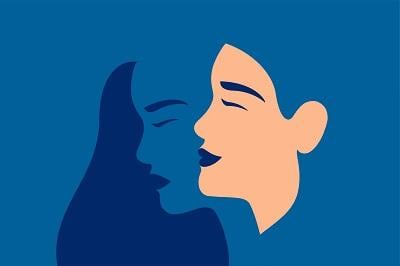
What is Depression?
Losing a loved one, getting fired from a job, going through a divorce, and other difficult situations can lead a person to feel sad, lonely and scared. These feelings are normal reactions to life's stressors. Most people feel low and sad at times. However, in the case of individuals who are diagnosed with depression as a psychiatric disorder, the manifestations of the low mood are much more severe and they tend to persist.
Depression occurs more often in women than men. Some differences in the manner in which how the depressed mood manifests have been found based on sex and age.
- In men, it manifests often as tiredness, irritability and anger. They may show more reckless behavior and abuse drugs and alcohol. They also tend to not recognize that they are depressed and fail to seek help. In women, depression tends to manifest as sadness, worthlessness, and guilt.
- In younger children depression is more likely to manifest as school refusal, anxiety when separated from parents, and worry about parents dying.
- Depressed teenagers tend to be irritable, sulky, and get into trouble in school. They also frequently have co-morbid anxiety, eating disorders, or substance abuse.
- In older adults, depression may manifest more subtly as they tend to be less likely to admit to feelings of sadness or grief and medical illnesses which are more common in this population also contributes or causes depression.
- Depression symptoms
- Depression treatment and management
Types of Depression
There are different types of depressive disorders, and while there are many similarities among them, each depressive disorder has its own unique set of symptoms.
The most commonly diagnosed form of depression is Major Depressive Disorder (MDD). In 2017, around 17.3 million aged 18 years or older in the U.S. had experienced at least one major depressive episode in the last year, which represented 6.7 percent of all American adults. Depression is the leading cause of disability in the United States among people ages 15-44. 2
Major depression is characterized by having at least five nine common symptoms. One of the symptoms must be either an overwhelming feeling of sadness or a loss of interest and pleasure in most usual activities.
The other symptoms that are associated with major depression include:
- decrease or increase in appetite,
- insomnia or hypersomnia,
- anhedonia. Anhedonia is one of the core symptoms of depression, often accompanied by feelings of sadness, hopelessness, and a lack of energy. Anhedonia is one of the two core symptoms of major depressive disorder and has been shown to be a distinct feature of depression. **
- psychomotor agitation or retardation,
- constant fatigue,
- feelings of worthlessness or excessive and inappropriate guilt,
- recurrent thoughts of death and suicidal ideation with or without specific plans for committing suicide, and
- cognitive difficulties, such as, diminished ability to think, concentrate and take decisions.
The symptoms must persist for two weeks or longer and represent a significant change from previous functioning. Social, occupational, educational, or other important functioning are impacted by major depressive disorder. For instance, the person may start missing work or school, or stop going to classes or their usual social activities.
About 60 percent of people who start medication for depression will have to try more than one medication before their symptoms go away (NAMI.org). Check out the different types of treatments for depression.
- Join ADAA's free peer to peer Major Depressive Disorder (MDD) online support group.
- Watch ADAA's What is Major Depressive Disorder (MDD)?
- To learn more in-depth about Major Depressive Disorder and treatments, check out ADAA's Patient Guide to Mood and Anxiety Disorders.
Persistent depressive disorder (dysthymia). The essential feature of this mood disorder is a low, dark or sad mood that is persistently present for most of the day and on most days, for at least 2 years (children and adolescents may experience predominantly irritability and the mood persist for at least 1 year). Read this ADAA blog: Dysthymia Shouldn’t be a ‘Way of Life’: How the Low-Grade Depression is Diagnosed & Treated. To learn more in-depth about Dysmythia and treatments, check out ADAA's Patient Guide to Mood and Anxiety Disorders.
Anhedonia can also be present in this chronic form of depression, where symptoms are less severe but last longer. For the individual to receive the diagnosis of persistent depressive disorder they should also have two of the diagnostic symptoms which include poor appetite or overeating, insomnia or hypersomnia, low energy or fatigue, low self-esteem, poor concentration, difficulty making decisions, or feelings of hopelessness. During this period, any symptom-free intervals last no longer than two months. The symptoms are not as severe as with major depression. Major depression may precede persistent depressive disorder, and major depressive episodes may also occur during persistent depressive disorder.
Premenstrual dysphoric disorder (PMDD) is another manifestation of depression which is a severe and sometimes disabling extension of premenstrual syndrome (PMS). Although regular PMS and PMDD both have physical and emotional symptoms, the mood changes in PMDD are much more severe and can disrupt social, occupational, and other important areas of functioning. In both PMDD and PMS, symptoms usually begin seven to 10 days before the start of a menstrual period and continue for the first few days of the period. Both PMDD and PMS may also cause breast tenderness, bloating, fatigue, and changes in sleep and eating habits. PMDD is characterized by emotional and behavioral symptoms that are more severe, such as sadness or hopelessness, anxiety or tension, extreme moodiness, irritability or anger.
Some medical conditions can trigger depressive symptoms in individuals. This is called depressive disorder due to another medical condition. Endocrine and reproductive system disorders are commonly associated with depressive symptoms. For example, people with low levels of the thyroid hormone (hypothyroidism) often experience fatigue, weight gain, irritability, memory loss, and low mood. When the hypothyroidism is treated it usually reduces the depression. Cushing's syndrome is another hormonal disorder caused by high levels of the hormone cortisol which can also cause depressive symptoms. Other conditions that have been found to cause depression include conditions such as HIV/AIDS, diabetes, strokes, Parkinson’s disease etc.
Adjustment Disorder with Depressed Mood is diagnosed when symptoms of depression are triggered within 3 months of onset of a stressor. The stressor usually involves a change of some kind in the life of the individual which he/she finds stressful. Sometimes the stressor can even be a positive event such as a new job, marriage, or baby which is nevertheless stressful for the individual. The distress is typically out of proportion to the expected reaction and the symptoms cause significant distress and impairment in functioning. The symptoms typically resolve within 6 months when the person begins to cope and adapt to the stressor, or when the stressor is removed. Treatment tends to be time limited and relatively simple since some additional support during the stressful period helps the person recover and adapt.
Seasonal Affective Disorder
Another type of depression is related to changes in the length of days or seasonality. This type of depression is called Seasonal affective disorder (SAD). People with SAD suffer the symptoms of a Major Depressive Disorder only during a specific time of year, usually winter. This appears to be related to the shorter days of winter, and the lack of sunlight in many parts of the country.
Seasonal affective disorder (SAD) is a type of depression that's related to a lack of sunlight or changes in seasons. Have you ever heard of the 'winter blues'? SAD is very similar to the winter blues but with increased symptoms. People with SAD suffer the symptoms of a Major Depressive Disorder during a specific time of year, usually winter. Learn more about SAD.
To learn more in-depth about Seasonal Affective Disorder and treatments, check out ADAA's Patient Guide to Mood and Anxiety Disorders.
Bipolar Disorder
Bipolar disorder, also known as manic-depressive illness, is a brain disorder that causes unusual shifts in a person's mood, energy, and ability to function.
The mood episodes associated with the disorder persist from days to weeks or longer, and can be dramatic, with periods of being overly high and/or irritable to periods of persistent sadness and hopelessness.
It can be helpful to think of bipolar disorder as a spectrum of moods.
A symptom of bipolar disorder is called Anhedonia. Anhedonia is the inability to experience joy or pleasure. You may feel numb or less interested in things that you once enjoyed. It’s a common symptom of many mental health conditions like depression and bipolar disorder. Treatment and medications are available to help you regain interest in life’s activities, like being around loved ones, going out, or listening to music.
At one end is severe depression, above which is moderate depression, and then mild low mood, which may be called the blues when it is short-lived and dysthymia when it is chronic. Learn more.
To learn more in-depth about Bipolar Disorder and treatments, check out ADAA's Patient Guide to Mood and Anxiety Disorders.
What Is Treatment-Resistant Depression (TRD)?
Treatment-resistant depression means different things to different people.
Most often, it means a person has tried two or more antidepressants for several weeks each and still has depressive symptoms. If you feel this way it is critical that you see your doctor again. Some common antidepressants are: Zoloft®, Celexa®, Lexapro®, Prozac®, Cymbalta®, Effexor®. New drugs may come on the market, thus speak to your doctor about your current medications and or any new medications that may be available.
Two medications approved by the Food and Drug Administration (FDA) for treatment-resistant depression are olanzapine/fluoxetine (Symbyax®) and intranasal esketamine (Spravato®).4 Another option for treatment-resistant depression is ketamine. This is given by injection in a clinic setting and improvement in symptoms can be seen in hours. Unfortunately, at this time it is not known how well this treatment works long-term.
Why Do Some People Have TRD?
- Family history of depression
- Genes that can lead to a poor response to medications
- Use of substances, such as alcohol or marijuana
- Side effects caused by medications
- Having illnesses that contribute to a depressed mood
- Ongoing home or life stressors
What Are Some Other Treatments That May Help?
Talk therapy has been shown to work for depression, even in people who have not gotten better from medication in the past.
Therapy can provide tools for dealing with life stressors that medication cannot help. It has also been shown that the effects of therapy can last longer than the effects of medications. Most people do better on both talk therapy and medication than just one alone
Additionally, there are certain brain stimulation procedures for treatment-resistant depression that are performed by a physician in a clinic. Transcranial magnetic stimulation (TMS) is done when a person is awake while electroconvulsive therapy (ECT) and vagus nerve stimulation (VNS) are done when a person is under sedation.
These are used when many different medications have failed to help depression symptoms.
Depression and Anxiety Disorders: Not the Same
Depression and anxiety disorders are different, but people with depression often experience symptoms similar to those of an anxiety disorder, such as nervousness, irritability, and problems sleeping and concentrating. But each disorder has its own causes and its own emotional and behavioral symptoms.
Many people who develop depression have a history of an anxiety disorder earlier in life. There is no evidence one disorder causes the other, but there is clear evidence that many people suffer from both disorders.
Sleep and Anxiety and Depression
Sources:
1. NIMH: Depression Basics
2. View the NIMH website for statistics from the 2017 National Survey on Drug Use and Health
3. American Psychiatric Association. (2013). Diagnostic and statistical manual of mental disorders (5th ed.). Arlington, VA: American Psychiatric Publishing.
4. Sadock, B. J., Sadock, V. A., & Ruiz, P. (2009). Comprehensive Textbook of Psychiatry (Ninth edition.) Philadelphia: Wolters Kluwer.
ADAA Resources:
- Download ADAA's Depression brochure
- Join ADAA's free peer-to-peer Anxiety and Depression community
- Join ADAA's free peer to peer Major Depressive Disorder (MDD) online support group
- ADAA Statement on Trauma - 2023
Videos
- What is Depression?
- What is Major Depressive Disorder (MDD)?
- Depression Signs and Symptoms, ADAA Member Paul Greene, PhD
- What is Postpartum Depression?
Webinars
- Depression: How to Recognize it and How to Treat it
- Can Yoga Help with Depression? What Does the Research Say?
- Depresión y ansiedad en niños/Anxiety and Depression in Children - Spanish psychoeducational video
- Depresión/Depression
- Depression Among College Students
- Depression and Heart Disease: Chicken and the Egg, and What You Can Do
- For My Anxiety or Depression: Should I Use Medication or Therapy?
- How to Help Depressed and Suicidal Teenagers
- Asking Your Pharmacist About Medications for Anxiety and Depression
- Anxiety, Depression, and the LGBTQ Community: Thriving Through the Challenges
- Exercise Against Anxiety and Depression
- Our Kids: Anxiety and Depression
- Treatments for Anxious and Depressed Kids and Teens
- Bullying, Anxiety, and Depression
- What Is Cognitive-Behavioral Therapy and How Is It Used to Treat Anxiety and Depression?
- Depression: What You Need to Know About Medications
- Genetics of Depression and Anxiety: What Do Clinicians Need to Know? - ADAA professional webinar
- Mindfulness Over Matter: Integrating Mindfulness Into the Treatment of Depression - Presented in Partnership with The Child Mind Institute - ADAA professional webinar
- Management of Treatment Resistant Depression - ADAA professional webinar
- Introduction to the Magic of CBT for Anxiety, OCD, and Depression - ADAA professional webinar
- Psychotherapy for GAD and Comorbid Major Depression - ADAA professional webinar
Blog Posts
- Hidden Links: The Common Threads of Mental Health Disorders
- Dysthymia Shouldn’t be a ‘Way of Life’: How the Low-Grade Depression is Diagnosed & Treated
- Depression Across the Lifespan: Depression—and its Treatments—are Different for Each Life Stage
- What is Depression? How Can We Overcome It?
- Is My Child Depressed?
- Childhood Depression
- Watch, Ask and Listen: How to Tell if Your Child or Teen is Anxious or Depressed
- How Do You Talk to Your Loved One Suffering With Depression?
- Revolutionizing Depression Treatment with Digital Therapeutics
- Dealing with Valentine's Day Depression
- Criticism: Depression and Anxiety
- Can CBD Help with My Anxiety and Depression
- Influences of Cultural Differences in the Diagnosis and Treatment of Anxiety and Depression
- Revolutionizing Depression Treatment with Digital Therapeutics
- Heart Disease and Depression Often Go Hand in Hand: WomenHeart Can Help -
- Depression Among College Students
- Anxiety and Depression in Sexual and Gender Minority Individuals
- Dr. Chris’s Techniques For Lessening Anxiety And Depression
- Seniors Coping with Anxiety and Depression
- Depression and Daily Life
- Alleviating Anxiety, Stress and Depression with the Pet Effect
- What is Depression and How Do I Know If I Have It?
- Depression Treatment – It Works
- Understanding Anxiety and Depression for LGBTQ People
Additional Resources
Articles
- That Lingering ‘Meh’ Feeling Has a Name (PDD), New York Times, Dec 4, 2023
- Positive affect and reward processing in the treatment of depression, anxiety and trauma, Nature Reviews Psychology.com, Michelle G.Craske, PhD, Alicia Meuret, Phd, Charles Taylor, PhD
- What Is Major Depressive Disorder?, HealthCentral, ADAA President Charles Nemeroff, MD, PhD
- Tips for How to Explain Depression So Other People Understand, Healthline, ADAA Member David Rosmarin, PhD, ABPP
- Faster and Easier Approaches for Improving Patients' Depression Treatment Outcomes, CareForYourMind.org, ADAA Member Michael Thase, MD
- What to Expect From Therapy for Depression—and How to Start the Process, Self Magazine
- Some of the best books about depression in 2021, Medical News Today
Community Resources
- Child Mind Institute
- Depression and Bipolar Support Alliance
- Depression Stories on The Mighty
- Disability Benefits
- HeadsUpGuys
- Hope for Depression Research Foundation
- I Had a Black Dog, His Name Was Depression
- Major Depression: The Impact on Overall Health
- National Institute of Mental Health
- World Health Organization
** Anhedonia (also referred to as the lack of positive mood) presents as “deficits in the capacity to feel pleasure and take interest in things” that were previously enjoyable.1
• Anhedonia is one of the two core symptoms for MDD diagnosis per the DSM-5 and ICD-11. 1-5
• Up to ~70% of patients with MDD have clinically significant anhedonia. 1,8,9
• Anhedonia results from dysregulation in multiple facets of reward processing (desire, anticipation, effort, and anticipatory/consummatory pleasure).10
• Symptoms vary across patients10,11:
• Diminished appetite and libido/sexual function
• Loss of bonding/making social connections with others
• Reduced anticipation of rewards
• Lack of consummatory pleasures (hedonic response to rewards)
• Loss of motivation to pursue goals (sometimes reported by patients as “fatigue” or “low energy”)
References:
1. World Health Organization. Depressive disorder (depression). Accessed March 2024. https://www.who.int/news-room/fact-sheets/detail/depression. [Link]
2. Bains N, Abdijadid S. Major Depressive Disorder. In: StatPearls. Treasure Island, FL: StatPearls Publishing; April 10, 2023. Available at: https://www.ncbi.nlm.nih.gov/books/NBK559078/
(accessed January 2023). [Link]
3. Fiorillo A, Sartorius N. Ann Gen Psychiatry 2021;20:52. [Link]
4. Bauer M, et al. Int J Psychiatry Clin Pract 2017;21:166–176. [Link]
5. Demyttenaere K. Cambridge University Press and Assess. 2024;1:355. [Link]
6. Gaynes BN, et al. Psychiatric Services. 2009;60:1439–1445. [Link]
7. Su YA and Si T. Gen Psychiatr 2022;35:e100724. [Link]
8. Gelenberg AJ, et al. Practice guideline for the Treatment of Patients With Major Depressive Disorder. American Psychiatric Association. 2010;3. [Link]
9. Lam RW, et al. Can J Psychiatry. 2024;0:0. [Link]
10. Depression in adults: treatment and management. NICE guideline. 29 June 2022. [Link]
11. Malhi GS, et al. ANZJP 2021;55:7-117. [Link]






















